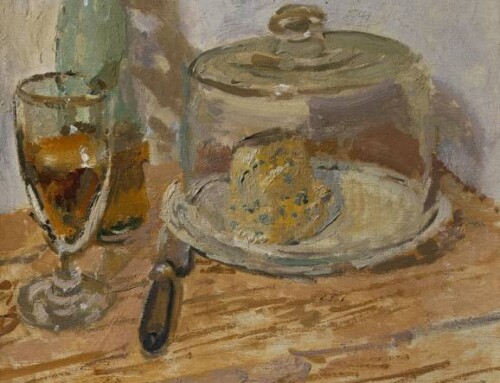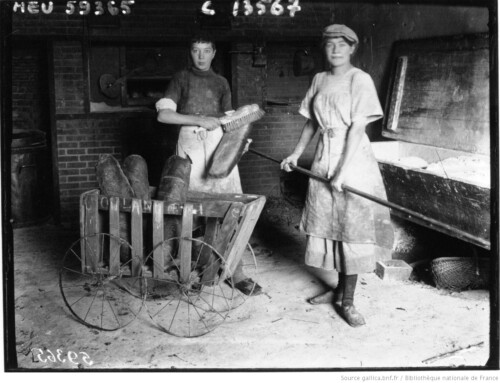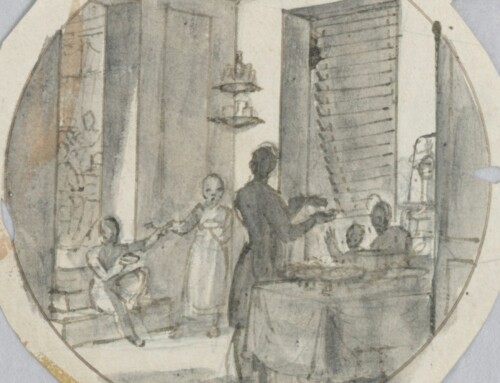The year is 1701. The dukes of Bourgogne and of Berry are passing through Montélimar, France. What would be something representative of Montélimar to give them? Nougat — a sweet made of egg whites, roasted nuts, and honey. And so Montélimar made 150 kilograms of nougat for the dukes. The town’s first nougat factory was created in 1770: Michel Fils Cadet. In an 1894 directory of the department of Drôme there is an advertisement for nougat made by the Trappist nuns of Montélimar. When Emile Loubet (1838-1929), a former mayor of Montélimar, became president of France in 1899, he promoted that town’s nougat heavily. As part of celebrating La Mi-Carême (mid-Lent) in 1924, there were three queens of nougat in Montélimar: Irène Bernard, Marguerite Brun, and Rose Mouyon, all of whom were put on a postcard. In Provence nowadays nougat is considered to be a traditional Christmas sweet. Nougat is what has put Montélimar on the map. Since 2006, Montélimar has been trying to obtain a label of IGP (Indication Géographique Protégée) for its nougat. How much more French can nougat become? Become, because nougat is not exactly French. Nougat from Turkey came to sixteenth-century France in the port city of Marseille, rather near Montélimar. Almonds, used in much of the nougat made in Montélimar, were newly available in the region only because Olivier de Serres (1539-1619) had planted almond trees imported from Asia. Early recipes for nougat of the type made in Montélimar can be found in thirteenth-century Arabic books such as the anonymous Kitab al-Tabikh fi-I-Magrib wa al-Andalus fi ’asr al-Muwwahaaidin and the Fudalat al-Khiwan by Ibn Razin al-Tujibi (active 1239-1265).
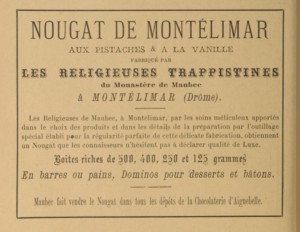
Nougat de Montélimar aux pistaches & à la vanille fabriqué par les Religieuses Trappistines du monastère de Maubec à Montélimar (Drôme). 1894, Annuaire commercial, industriel et administratif du département de la Drôme. Bibliothèque nationale de France → https://gallica.bnf.fr/ark:/12148/bpt6k97618786/f260.image.r=Mont%C3%A9limar,%20nougat?rk=107296;4

Article from L’Aurore : littéraire, artistique, sociale / dir. Ernest Vaughan ; réd. Georges Clemenceau. Paris, 1898-02-18, page 3. Bibliothèque nationale de France → https://gallica.bnf.fr/ark:/12148/bpt6k7014893/f3.item.r=nougat.zoom

Marchand de nougats : photographie / Eugène Atget (1857-1927). 1899-1900. Bibliothèque nationale de France → https://catalogue.bnf.fr/ark:/12148/cb402680589
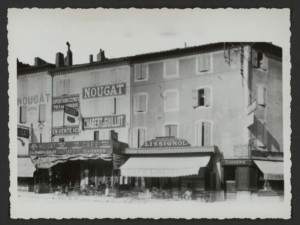
Magasin de nougat à Montélimar. Early 20th Century. Attribution: Médiathèques Valence Romans agglomération [CC BY 2.0 (https://creativecommons.org/licenses/by/2.0)], via Wikimedia Commons → https://commons.wikimedia.org/wiki/File:Magasin_de_nougat_%C3%A0_Mont%C3%A9limar_(34675449776).jpg . See also → https://www.lempreinte.valenceromansagglo.fr/magasin-de-nougat-a-montelimar,B263626101_X32.htm
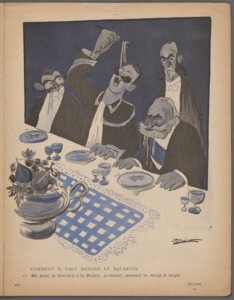
“Comment il faut manger le macaroni. –Moi aussi, je monterai à Sa Majesté, au dessert, comment on mange le nougat.” 1903. Issue no. 133 of L’Assiette au Beurre, page 2237. The New York Public Library Digital Collections. The Miriam and Ira D. Wallach Division of Art, Prints and Photographs: Print Collection, The New York Public Library. → https://digitalcollections.nypl.org/items/6702c920-bcb3-0130-0635-58d385a7b928
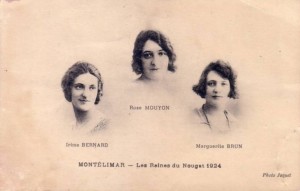
Marguerite Brun, Rose Mouyon et Irène Bernard, reines du Nougat, Montélimar 1924. Carte-postale d’époque. Attribution: Joguet [Public domain], via Wikimedia Commons → https://commons.wikimedia.org/wiki/File:Mont%C3%A9limar_-_Reines_du_Nougat_1924.jpg

Gaz (Persian nougat). 2016. Photo credit: Majid Eslamdoust. Source: Iran Front Page. Creative Commons Attribution 4.0 International License → https://ifpnews.com/iran-photos/gaz-candy-traditional-souvenir-of-irans-isfahan/
▀▄▀▄▀▄
References & Suggested Reading
“A voir ce ‘tunnel du Simplon’ ouvert au flan d’une montagne de nougat, ce ‘triomphe de Neptune’, ce ‘fort de Kharbine’, on peut constater que le goût de l’allégorie n’exclut pas le sens de l’actualité.” Date? Bibliothèque interuniversitaire de Santé. → https://www.biusante.parisdescartes.fr/histmed/image?CISB0647 . Accessed January 2019.
al-Tujibi, Ibn Razin (active 1239-1265). Saveurs et parfums de l’Occident musulman : les délices de la table et les meilleurs genres de mets : traduction du livre “Fudalat al-Khiwan Fi Tayibat at-Tàam wa al Alwan.” Translated by Mohamed Mezzine and Laila Benkirane. Fès: Publications Association Fès-Saïs, 1997.
Annuaire commercial, industriel et administratif du département de la Drôme. Valence: 1894.
Caussé, Bruno. « Le nougat aux œufs d’or. » Le Monde. 19 mars 2008. → https://www.lemonde.fr/vous/article/2008/03/19/le-nougat-aux-oeufs-d-or_1025008_3238.html . Accessed January 2019.
Delarzes, Alfred. Le nougat de Montélimar [poème dédié à la Maison Mège]. Circa 1880. → https://www.lempreinte.valenceromansagglo.fr/le-nougat-de-montelimar-poeme-dedie-a-la-maison-mege,D29811-1.htm . Accessed January 2019.
Durand, Jean. Le nougat de Montélimar : Légende, histoire, portraits. Pont-Saint-Esprit, France: La Mirandole, 1993.
Goldstein, Darra, and Sidney Mintz. The Oxford Companion to Sugar and Sweets. Oxford University Press, 2015.
Grami, Bahram. “Gaz of Khunsar: The Manna of Persia.” Economic Botany, vol. 52, no. 2, 1998, pp. 183–191. → https://doi.org/10.1007/BF02861207 . Accessed January 2019.
Hopkins, Kate. Sweet Tooth: The Bittersweet History of Candy. Macmillan, 2012.
Huici Miranda, Ambrosio, and Manuela Marín. La cocina hispano-magrebí durante la época almohade : según un manuscrito anónimo del siglo XIII. Somonte-Cenero, Gijón: Ediciones Trea, 2005.
Isin, Mary. Sherbet and Spice: The Complete Story of Turkish Sweets and Desserts. IB Tauris, 2013.
“Mésaventures d’Abidi-Ali-ben-Moussah.” L’Aurore : littéraire, artistique, sociale / dir. Ernest Vaughan ; réd. Georges Clemenceau. Paris, 1898-02-18, page 3. → https://gallica.bnf.fr/ark:/12148/bpt6k7014893/f3.item.r=nougat.zoom . Accessed January 2019.
“Nougat.” Dictionnaire analogique et étymologique des idiomes méridionaux qui sont parlés depuis Nice jusqu’à Bayonne et depuis les Pyrénées jusqu’au centre de la France : comprenant tous les termes vulgaires de la flore et de la faune méridionale, un grand nombre de citations prises dans les meilleurs auteurs, ainsi qu’une collection de proverbes locaux tirés de nos moralistes populaires. Vol. 1, 1875.
“Nougats au Salon du Chocolat 2017 — Parc des Expositions — Porte de Versailles, 28 October 2017.” Attribution: Sukkoria [CC BY-SA 4.0 (https://creativecommons.org/licenses/by-sa/4.0)], from Wikimedia Commons → https://commons.wikimedia.org/wiki/File:Salon_chocolat_Paris_2017_Nougats_2899.jpg
Plouvier, Liliane. « Le rôle d’Al-Andalus dans la transmission des connaissances de l’Orient vers l’Occident. » Horizons Maghrébins – Le droit à la mémoire, N°55, 2006. Manger au Maghreb, sous la direction de Mohamed Oubahli. pp. 30-47. DOI : https://doi.org/10.3406/horma.2006.2373 . Accessed January 2019.
– – – . « L’introduction du sucre en pharmacie. » Revue d’histoire de la pharmacie, 87ᵉ année, n°322, 1999. pp. 199-216. DOI : https://doi.org/10.3406/pharm.1999.4740 . Accessed January 2019.
Pudlowski, Gilles. Les trésors gourmands de la France. Renaissance du livre, 2000.
Robuchon, Joël, and Prosper Montagné. Larousse gastronomique: The World’s Greatest Culinary Encyclopedia. New York: Clarkson Potter, 2009.
Sender, S. G., and Marcel Derrien. La grande histoire de la pâtisserie-confiserie française. Minerva, 2003.
Serres, Olivier de. Le théâtre d’agriculture et mesnage des champs. Genève: Slatkine, 1991.
Tosseri, Bénévent. « A Montélimar, les nougatiers font leur miel. » La Croix. 22 août 2017. → https://www.la-croix.com/Economie/France/A-Montelimar-nougatiers-font-leur-miel-2017-08-22-1200871140 . Accessed January 2019.

